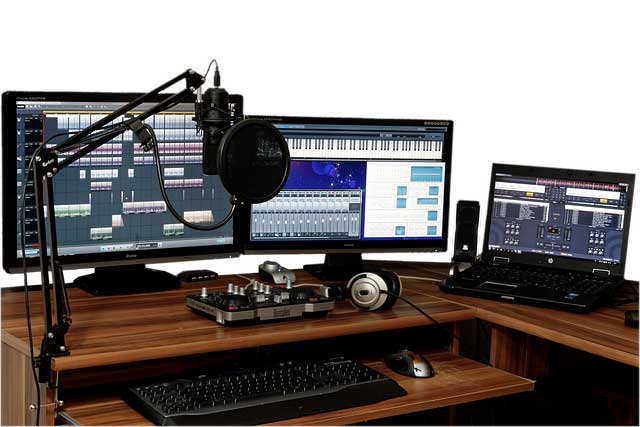Whether you're a podcasting beginner or you're a seasoned pro looking to elevate your game, having the right gear is essential for creating high-quality content that keeps your audience engaged.
That's why we've put together this guide to help you navigate the vast ocean of podcasting tools available today.
Our goal is to make your life easier by breaking down the best tools for podcasting into five categories: audio and video recording gear, hosting platforms, remote interviewing tools, audio editing software, and transcription tools.
Each section will dive deep into the top equipment and software options, offering insights and recommendations so you can make informed decisions and find the perfect tools to suit your unique podcasting needs.
Let's get started!
Disclosure: Although I receive affiliate compensation at no additional cost to you to support this site that compensation in no way influences my recommendations, which are strictly informed by my 10+ years of online business experience consulting for clients large and small. My aim is to always recommend tools that offer the best return for your investment (for more details, read my Affiliate Disclosure).
What Tools Do You Need for Podcasting?
Let's cover the five sets of tools and software required for producing a sharp and polished podcast, including a short review of the top three choices for each category plus links to vendors:
1. Audio and Video Recording Gear

Microphones
A good microphone is crucial for capturing clear, professional-quality audio. Here are a few popular options to consider:
- Shure SM7B Mic: This microphone is a favorite among podcasters, and for a good reason. It offers excellent sound quality and eliminates background noise to produce a clear and crisp sound. With a built-in pop filter, this mic is perfect for capturing speech and singing, making it a versatile option for any podcast. It's also durable and well-built, ensuring it will last for years of use.
- Audio Technica AT2035 Mic: This is another popular choice among podcasters. It's a large diaphragm condenser microphone that offers a warm and natural sound. With its cardioid polar pattern, this mic is great for isolating your voice and minimizing room noise. It also has a high SPL handling, making it suitable for recording louder sounds such as musical instruments.
- Blue Yeti X Mic: This is a popular USB microphone that offers excellent sound quality, versatility, and convenience. It features a four-capsule array that captures clear and detailed sound, as well as a built-in LED meter that displays your volume level. With a range of pickup patterns and a variety of settings to choose from, this microphone is perfect for podcasters who want a high-quality sound without the fuss of a more complex setup.
Webcams
If you're planning to record video podcasts, investing in a good camera can make a huge difference in the quality of your content. Some options to consider include:
- Logitech C922x Pro Webcam: This is a popular webcam for podcasters and video creators. It delivers high-definition video and clear audio, making it ideal for recording podcast episodes with video. It's easy to use and set up, with a universal clip that allows you to attach it to your computer or laptop. This webcam is also great for streaming live events and video conferences.
- Logitech StreamCam: This is another popular webcam for podcasters and streamers. It features a high-quality lens and dual-microphone system that captures clear and detailed video and audio. With its versatile mounting options and USB-C connectivity, this webcam is easy to use and perfect for creating professional-quality video content.
- Logitech Brio Webcam: This is a top-of-the-line webcam that offers 4K ultra HD video and HDR imaging technology. With its high-resolution sensor and advanced optics, it captures detailed and lifelike video that's perfect for podcasting and video creation. It also features advanced security features, such as infrared facial recognition and a privacy shutter, making it a great option for podcasters who value privacy and security.
Mic Stands with Shock Mounts
A sturdy mic stand and shock mount can help reduce vibrations and unwanted noise during recording.
Some options to check out are:
- Innogear Mic Stand: This heavy-duty scissor boom arm stand features a solid steel construction and a foldable design, making it easy to store and transport. The stand also comes with a shock mount and a pop filter to help improve the quality of your recordings.
- Kasonic Mic Stand: This mic stand is designed to provide stable and flexible support for your microphone. It comes with a professional shock mount that helps to reduce unwanted noise and vibration, and the adjustable arm allows you to position your mic exactly where you need it.
- Cahaya Mic Stand: This all-metal mic stand is durable and stable, and comes with a shock mount and a pop filter to help improve the clarity of your recordings. The stand also features a double-braced design for extra stability, and the adjustable arm allows you to easily position your mic.
Headphones
A good pair of headphones is essential for monitoring your audio while recording and editing. Some popular options include:
- Beyerdynamic DT 770 Pro Headphones: These headphones are known for their exceptional sound quality and comfortable fit. They come in a range of impedance options, so you can choose the best one for your recording setup.
- Sennheiser HD 280 Pro Headphones: These headphones are designed to provide accurate and detailed sound reproduction, making them a great choice for podcasters who want to ensure their audio sounds its best.
- Sony MDR 7506 Headphones: These headphones have been a popular choice for audio professionals for decades, and for good reason. They provide excellent sound quality and comfort at an affordable price point.
Lighting Equipment
If you're recording video podcasts, proper lighting is key to achieving a professional look. Here are some lighting options to consider:
- Neewer Lighting: Neewer offers a range of affordable lighting options for podcasters, including ring lights, softbox lights, and LED panel lights. Their equipment is lightweight, easy to use, and provides excellent lighting quality for your video content.
- Inkeltech Lighting: Inkeltech offers a range of lighting options for podcasters, including ring lights and panel lights. Their lights are dimmable and adjustable, allowing you to customize the lighting for your specific needs. Inkeltech's lights also come with a remote control for easy adjustments during recording.
- Sensyne Lighting: Sensyne offers a variety of affordable lighting options for podcasters, including ring lights, softbox lights, and LED panel lights. Their equipment is lightweight, portable, and easy to set up, making it a great option for podcasters who need to record in different locations. Sensyne's lights are also dimmable, allowing you to adjust the lighting to fit your specific needs.
2. Podcast Hosting Platforms

A reliable hosting platform is essential for storing and distributing your podcast episodes. Some popular choices include:
- Buzzsprout: Buzzsprout offers an easy-to-use platform with great features, such as automatic distribution to major podcast directories and a customizable podcast player. It also offers detailed analytics to help you track your audience's engagement.
- Libsyn: Libsyn is one of the oldest and most reliable podcast hosting platforms. It offers unlimited storage and bandwidth, as well as easy integration with popular website builders and social media platforms.
- Spreaker: Spreaker offers a comprehensive platform for hosting, recording, and live streaming podcasts. It offers unique features like live chat during broadcasts and the ability to co-host shows remotely. It also offers detailed analytics and automatic distribution to major podcast directories.
3. Remote Interviewing Tools

If you're conducting interviews with guests who can't join you in person, having reliable remote interviewing tools is a must. Here are a few options to consider:
SquadCast: This platform offers high-quality audio recording and video conferencing capabilities, ensuring a seamless interview experience.
Zoom: A popular video conferencing tool that also allows you to record your calls for podcasting purposes.
Riverside.fm: This service specializes in recording high-quality audio and video interviews, with separate tracks for easy editing.
4. Audio Editing Software

Editing is crucial for producing polished, professional-sounding podcasts. Here are some top audio editing software options:
- Audacity: This is a free and open-source audio editing software that offers a range of features for podcasters. With its simple and user-friendly interface, Audacity allows you to edit and mix multiple tracks, apply sound effects, and enhance the quality of your audio recordings. It also supports a range of file formats, making it easy to export your finished podcast to your desired platform.
- Garageband (note: this software only works with Apple devices): This is a popular digital audio workstation developed by Apple that offers a range of features for podcasters. With its intuitive interface and powerful tools, GarageBand allows you to create, edit, and mix your podcast episodes with ease. It also includes a range of built-in sound effects and music tracks, making it a great choice for podcasters who want to add a professional touch to their episodes.
- Adobe Audition: This is a professional-grade audio editing software that offers advanced features for podcasters. With its powerful tools for noise reduction, compression, and equalization, Adobe Audition allows you to create high-quality podcast episodes with ease. It also includes a range of advanced features such as multi-track editing, batch processing, and advanced effects processing, making it a great choice for podcasters who want to take their editing to the next level.
5. Transcription Tools

Transcribing your podcast episodes can improve accessibility and boost your SEO. Check out these transcription tools:
- Descript: This is an AI-powered transcription and audio editing software that allows you to create accurate transcripts of your podcast episodes in real-time. With its intuitive interface, you can easily edit your audio and text simultaneously, making it a great tool for podcasters who want to streamline their editing process. Descript also allows you to easily generate and export captions, making your podcast more accessible and searchable.
- Otter: This is another popular transcription tool that uses AI technology to generate accurate and reliable transcripts of your podcast episodes. Its easy-to-use interface and automatic syncing feature make it a great choice for podcasters who want a hassle-free transcription process. Otter also allows you to export your transcripts in various formats, making it easy to share and repurpose your content.
- Rev: This is a professional transcription service that offers accurate and high-quality transcripts for your podcast episodes. With its fast turnaround time and competitive pricing, it's a great choice for podcasters who want to outsource their transcription work. Rev also offers other services such as captioning and translation, making it a one-stop-shop for all your podcasting needs.
How to Set Up Your Podcast Tools
Now that you're armed with knowledge about the best podcasting tools, it's time to set them up and start creating your amazing content.
Here's a step-by-step guide to help you get everything in place, from choosing your recording space to establishing a podcast schedule.
By following these simple steps, you'll be well on your way to creating a professional and engaging podcast that your audience will love.
1. Choose Your Recording Space
First things first, you'll want to find a quiet, well-lit space to set up your recording equipment.
Look for a room with minimal background noise, preferably one with soft surfaces like carpets, curtains, or even strategically placed blankets to absorb sound and minimize echo.
A space with controlled lighting, or at least a room where you can block out natural light, will also help you achieve consistent video quality when using cameras.
2. Set Up Your Recording Equipment
Once you've found the perfect space, it's time to set up your microphone, camera, and lighting equipment.
Position your microphone close to your mouth, ideally at a slight angle to avoid plosives (those pesky "p" and "b" sounds that can cause distortion).
Connect your mic to your computer or audio interface, and don't forget to test the levels before recording to ensure optimal audio quality.
If you're using a camera, set it up at eye level to create a more natural and engaging perspective for your viewers.
Finally, arrange your lighting equipment to eliminate shadows and create a flattering, well-lit environment.
3. Choose Your Remote Interviewing Tools
If your podcast involves interviewing guests, you'll need a reliable remote interviewing platform. Look for a tool that meets your needs in terms of audio quality, video capabilities, and ease of use.
Some popular options include SquadCast, Zoom, and Riverside.fm. Test out different platforms to find the one that works best for you and your guests.
4. Choose Your Podcast Hosting Platform
To share your podcast with the world, you'll need a hosting platform. Research various options and sign up for the one that offers the features, storage, and analytics tools that best suit your needs.
Remember to consider factors like pricing, ease of use, and integration with your preferred podcast directories.
5. Choose Your Editing Software
Great podcasts are polished and professional, which is why you'll need audio editing software that matches your skill level and offers the necessary tools.
Some popular choices include Audacity for beginners, Adobe Audition for more advanced users, and Reaper for those seeking a customizable, powerful digital audio workstation.
6. Choose Your Transcription Tools
Transcribing your podcast episodes not only makes them more accessible but can also boost your SEO.
Select a transcription service or software that delivers accurate transcriptions and fits your budget. Some noteworthy options include Otter.ai, Rev.com, and Descript.
7. Create a Podcast Schedule
Consistency is key to keeping your audience engaged and growing your podcast following. Establish a recording and publishing schedule that works for you, whether it's weekly, bi-weekly, or monthly.
By sticking to a schedule, you'll not only keep your content fresh but also build anticipation and loyalty among your listeners.
Wrapping Things Up
In the fast-paced world of podcasting, using the right tools can make all the difference between a forgettable podcast and one that captivates your audience.
As you've discovered throughout this article, there's a wide range of equipment and software available to help you produce the most polished possible podcast episodes.
Take the time to learn the ins and outs of your chosen equipment and software, and experiment with different setups to find what works best for your unique voice and style.
Happy podcasting!







